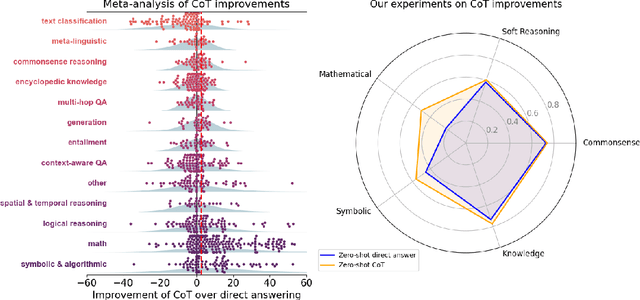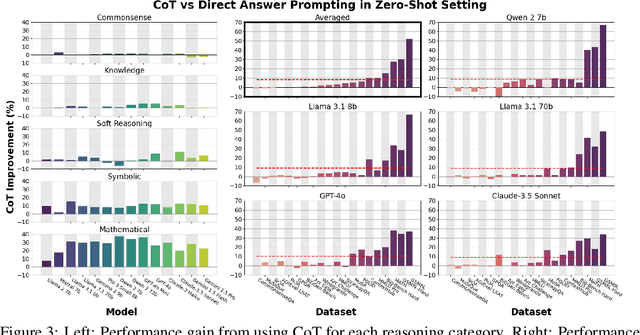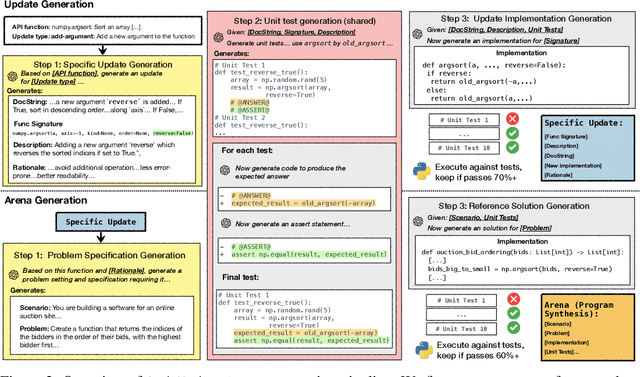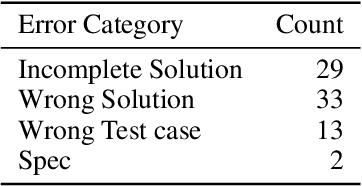Xi Ye
Query-Focused Retrieval Heads Improve Long-Context Reasoning and Re-ranking
Jun 11, 2025Abstract:Recent work has identified retrieval heads (Wu et al., 2025b), a subset of attention heads responsible for retrieving salient information in long-context language models (LMs), as measured by their copy-paste behavior in Needle-in-a-Haystack tasks. In this paper, we introduce QRHEAD (Query-Focused Retrieval Head), an improved set of attention heads that enhance retrieval from long context. We identify QRHEAD by aggregating attention scores with respect to the input query, using a handful of examples from real-world tasks (e.g., long-context QA). We further introduce QR- RETRIEVER, an efficient and effective retriever that uses the accumulated attention mass of QRHEAD as retrieval scores. We use QR- RETRIEVER for long-context reasoning by selecting the most relevant parts with the highest retrieval scores. On multi-hop reasoning tasks LongMemEval and CLIPPER, this yields over 10% performance gains over full context and outperforms strong dense retrievers. We also evaluate QRRETRIEVER as a re-ranker on the BEIR benchmark and find that it achieves strong zero-shot performance, outperforming other LLM-based re-rankers such as RankGPT. Further analysis shows that both the querycontext attention scoring and task selection are crucial for identifying QRHEAD with strong downstream utility. Overall, our work contributes a general-purpose retriever and offers interpretability insights into the long-context capabilities of LMs.
Learning to Reason Across Parallel Samples for LLM Reasoning
Jun 10, 2025Abstract:Scaling test-time compute brings substantial performance gains for large language models (LLMs). By sampling multiple answers and heuristically aggregate their answers (e.g., either through majority voting or using verifiers to rank the answers), one can achieve consistent performance gains in math domains. In this paper, we propose a new way to leverage such multiple sample set. We train a compact LLM, called Sample Set Aggregator (SSA), that takes a concatenated sequence of multiple samples and output the final answer, optimizing it for the answer accuracy with reinforcement learning. Experiments on multiple reasoning datasets show that SSA outperforms other test-time scaling methods such as reward model-based re-ranking. Our approach also shows a promising generalization ability, across sample set sizes, base model families and scales, and tasks. By separating LLMs to generate answers and LLMs to analyze and aggregate sampled answers, our approach can work with the outputs from premier black box models easily and efficiently.
Learning Composable Chains-of-Thought
May 28, 2025Abstract:A common approach for teaching large language models (LLMs) to reason is to train on chain-of-thought (CoT) traces of in-distribution reasoning problems, but such annotated data is costly to obtain for every problem of interest. We want reasoning models to generalize beyond their training distribution, and ideally to generalize compositionally: combine atomic reasoning skills to solve harder, unseen reasoning tasks. We take a step towards compositional generalization of reasoning skills when addressing a target compositional task that has no labeled CoT data. We find that simply training models on CoT data of atomic tasks leads to limited generalization, but minimally modifying CoT formats of constituent atomic tasks to be composable can lead to improvements. We can train "atomic CoT" models on the atomic tasks with Composable CoT data and combine them with multitask learning or model merging for better zero-shot performance on the target compositional task. Such a combined model can be further bootstrapped on a small amount of compositional data using rejection sampling fine-tuning (RFT). Results on string operations and natural language skill compositions show that training LLMs on Composable CoT outperforms multitask learning and continued fine-tuning baselines within a given training data budget.
RA-DP: Rapid Adaptive Diffusion Policy for Training-Free High-frequency Robotics Replanning
Mar 06, 2025Abstract:Diffusion models exhibit impressive scalability in robotic task learning, yet they struggle to adapt to novel, highly dynamic environments. This limitation primarily stems from their constrained replanning ability: they either operate at a low frequency due to a time-consuming iterative sampling process, or are unable to adapt to unforeseen feedback in case of rapid replanning. To address these challenges, we propose RA-DP, a novel diffusion policy framework with training-free high-frequency replanning ability that solves the above limitations in adapting to unforeseen dynamic environments. Specifically, our method integrates guidance signals which are often easily obtained in the new environment during the diffusion sampling process, and utilizes a novel action queue mechanism to generate replanned actions at every denoising step without retraining, thus forming a complete training-free framework for robot motion adaptation in unseen environments. Extensive evaluations have been conducted in both well-recognized simulation benchmarks and real robot tasks. Results show that RA-DP outperforms the state-of-the-art diffusion-based methods in terms of replanning frequency and success rate. Moreover, we show that our framework is theoretically compatible with any training-free guidance signal.
LongProc: Benchmarking Long-Context Language Models on Long Procedural Generation
Jan 09, 2025



Abstract:Existing benchmarks for evaluating long-context language models (LCLMs) primarily focus on long-context recall, requiring models to produce short responses based on a few critical snippets while processing thousands of irrelevant tokens. We introduce LongProc (Long Procedural Generation), a new benchmark that requires both the integration of highly dispersed information and long-form generation. LongProc consists of six diverse procedural generation tasks, such as extracting structured information from HTML pages into a TSV format and executing complex search procedures to create travel plans. These tasks challenge LCLMs by testing their ability to follow detailed procedural instructions, synthesize and reason over dispersed information, and generate structured, long-form outputs (up to 8K tokens). Furthermore, as these tasks adhere to deterministic procedures and yield structured outputs, they enable reliable rule-based evaluation. We evaluate 17 LCLMs on LongProc across three difficulty levels, with maximum numbers of output tokens set at 500, 2K, and 8K. Notably, while all tested models claim a context window size above 32K tokens, open-weight models typically falter on 2K-token tasks, and closed-source models like GPT-4o show significant degradation on 8K-token tasks. Further analysis reveals that LCLMs struggle to maintain long-range coherence in long-form generations. These findings highlight critical limitations in current LCLMs and suggest substantial room for improvement. Data and code available at: https://princeton-pli.github.io/LongProc
To CoT or not to CoT? Chain-of-thought helps mainly on math and symbolic reasoning
Sep 18, 2024



Abstract:Chain-of-thought (CoT) via prompting is the de facto method for eliciting reasoning capabilities from large language models (LLMs). But for what kinds of tasks is this extra ``thinking'' really helpful? To analyze this, we conducted a quantitative meta-analysis covering over 100 papers using CoT and ran our own evaluations of 20 datasets across 14 models. Our results show that CoT gives strong performance benefits primarily on tasks involving math or logic, with much smaller gains on other types of tasks. On MMLU, directly generating the answer without CoT leads to almost identical accuracy as CoT unless the question or model's response contains an equals sign, indicating symbolic operations and reasoning. Following this finding, we analyze the behavior of CoT on these problems by separating planning and execution and comparing against tool-augmented LLMs. Much of CoT's gain comes from improving symbolic execution, but it underperforms relative to using a symbolic solver. Our results indicate that CoT can be applied selectively, maintaining performance while saving inference costs. Furthermore, they suggest a need to move beyond prompt-based CoT to new paradigms that better leverage intermediate computation across the whole range of LLM applications.
CodeUpdateArena: Benchmarking Knowledge Editing on API Updates
Jul 08, 2024



Abstract:Large language models (LLMs) are increasingly being used to synthesize and reason about source code. However, the static nature of these models' knowledge does not reflect the fact that libraries and API functions they invoke are continuously evolving, with functionality being added or changing. While numerous benchmarks evaluate how LLMs can generate code, no prior work has studied how an LLMs' knowledge about code API functions can be updated. To fill this gap, we present CodeUpdateArena, a benchmark for knowledge editing in the code domain. An instance in our benchmark consists of a synthetic API function update paired with a program synthesis example that uses the updated functionality; our goal is to update an LLM to be able to solve this program synthesis example without providing documentation of the update at inference time. Compared to knowledge editing for facts encoded in text, success here is more challenging: a code LLM must correctly reason about the semantics of the modified function rather than just reproduce its syntax. Our dataset is constructed by first prompting GPT-4 to generate atomic and executable function updates. Then, for each update, we generate program synthesis examples whose code solutions are prone to use the update. Our benchmark covers updates of various types to 54 functions from seven diverse Python packages, with a total of 670 program synthesis examples. Our experiments show that prepending documentation of the update to open-source code LLMs (i.e., DeepSeek, CodeLlama) does not allow them to incorporate changes for problem solving, and existing knowledge editing techniques also have substantial room for improvement. We hope our benchmark will inspire new methods for knowledge updating in code LLMs.
LoFiT: Localized Fine-tuning on LLM Representations
Jun 03, 2024



Abstract:Recent work in interpretability shows that large language models (LLMs) can be adapted for new tasks in a learning-free way: it is possible to intervene on LLM representations to elicit desired behaviors for alignment. For instance, adding certain bias vectors to the outputs of certain attention heads is reported to boost the truthfulness of models. In this work, we show that localized fine-tuning serves as an effective alternative to such representation intervention methods. We introduce a framework called Localized Fine-Tuning on LLM Representations (LoFiT), which identifies a subset of attention heads that are most important for learning a specific task, then trains offset vectors to add to the model's hidden representations at those selected heads. LoFiT localizes to a sparse set of heads (3%) and learns the offset vectors from limited training data, comparable to the settings used for representation intervention. For truthfulness and reasoning tasks, we find that LoFiT's intervention vectors are more effective for LLM adaptation than vectors from representation intervention methods such as Inference-time Intervention. We also find that the localization step is important: selecting a task-specific set of attention heads can lead to higher performance than intervening on heads selected for a different task. Finally, for the tasks we study, LoFiT achieves comparable performance to other parameter-efficient fine-tuning methods such as LoRA, despite modifying 20x-200x fewer parameters than these methods.
Unveiling the Impact of Coding Data Instruction Fine-Tuning on Large Language Models Reasoning
May 30, 2024



Abstract:Instruction Fine-Tuning (IFT) significantly enhances the zero-shot capabilities of pretrained Large Language Models (LLMs). While coding data is known to boost reasoning abilities during LLM pretraining, its role in activating internal reasoning capacities during IFT remains understudied. This paper investigates a key question: How does coding data impact LLMs' reasoning capacities during the IFT stage? To explore this, we thoroughly examine the impact of coding data across different coding data proportions, model families, sizes, and reasoning domains, from various perspectives. Specifically, we create three IFT datasets with increasing coding data proportions, fine-tune six LLM backbones across different families and scales on these datasets, evaluate the tuned models' performance across twelve tasks in three reasoning domains, and analyze the outcomes from three broad-to-granular perspectives: overall, domain-level, and task-specific. Our holistic analysis provides valuable insights in each perspective. First, coding data tuning enhances the overall reasoning capabilities of LLMs across different model families and scales. Moreover, the effect of coding data varies among different domains but shows consistent trends across model families and scales within each domain. Additionally, coding data generally yields comparable task-specific benefits across different model families, with the optimal coding data proportions in IFT datasets being task-specific.
CityLLaVA: Efficient Fine-Tuning for VLMs in City Scenario
May 06, 2024



Abstract:In the vast and dynamic landscape of urban settings, Traffic Safety Description and Analysis plays a pivotal role in applications ranging from insurance inspection to accident prevention. This paper introduces CityLLaVA, a novel fine-tuning framework for Visual Language Models (VLMs) designed for urban scenarios. CityLLaVA enhances model comprehension and prediction accuracy through (1) employing bounding boxes for optimal visual data preprocessing, including video best-view selection and visual prompt engineering during both training and testing phases; (2) constructing concise Question-Answer sequences and designing textual prompts to refine instruction comprehension; (3) implementing block expansion to fine-tune large VLMs efficiently; and (4) advancing prediction accuracy via a unique sequential questioning-based prediction augmentation. Demonstrating top-tier performance, our method achieved a benchmark score of 33.4308, securing the leading position on the leaderboard. The code can be found: https://github.com/alibaba/AICITY2024_Track2_AliOpenTrek_CityLLaVA
 Add to Chrome
Add to Chrome Add to Firefox
Add to Firefox Add to Edge
Add to Edge